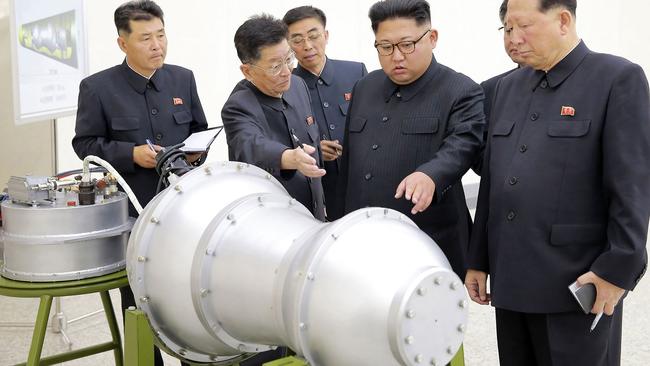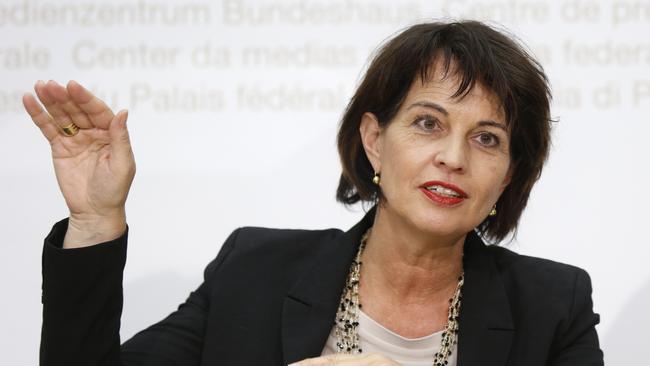North Korea is ready to fire another missile: reports
LATEST: North Korea is giving signs that it is preparing to launch more missiles and fire them toward the Pacific.

SOUTH Korea’s defence ministry has confirmed North Korea appears to be readying the launch of a ballistic missile after its biggest-ever nuclear test.
Seoul believes Kim Jong-un is preparing to fire a guided intercontinental ballistic missile, known as an ICBM. Worse, South Korea’s spy agency says he might fire the missile towards the Pacific.
Neutral Switzerland is prepared to act as mediator to help resolve the North Korea crisis, including by hosting ministerial talks, Swiss President Doris Leuthard says.
Leuthard said Swiss troops were deployed on the demarcation zone between South Korea and North Korea and noted that her country - along with Sweden - had a long history of neutral and discreet diplomacy.
But China and the United States had to take their share of responsibility, she added, warning of “overreactions”.
Sanctions “did not change many things” in terms of convincing Pyongyang to abandon its weapons programs even though North Korea’s population had suffered, Leuthard said.
A day after the North’s largest nuclear test yet, Seoul said it was talking to Washington about deploying aircraft carriers and strategic bombers to the Korean peninsula after signs Pyongyang might launch more missiles.
“I think it really is time for dialogue,” Leuthard told a news conference in Berne.

“...We are ready to offer our role for good services as a mediator. I think in the upcoming weeks a lot will depend on how the US and China can have an influence in this crisis. That’s why I think Switzerland and Sweden can have a role behind the curtain.” Part of the task would be to find a suitable location for officials to meet, she said.
“I think that’s our role to look at what kind of possibilities we find. Because, well, Twitter won’t be an adequate instrument... This must be very discreet.” Noting that the Communist Party congress in North Korea’s neighbour and ally China was due to take place in October, Leuthard said the time for such initiatives was not ideal, so “perhaps this was also part of the plan of North Korea.” North Korean leader Kim Jong-un spent part of his youth in Berne studying under an assumed name.
China has warned North Korea against proceeding with its reported plans to launch another ballistic missile, saying it should not worsen tensions. Chinese foreign ministry spokesman Geng Shuang told reporters Monday that North Korea “must be very clear” that UN Security Council resolutions prohibit such activities.
In Beijing, Geng said China hopes all parties, especially North Korea, “exercise restraint and refrain from further escalating tensions.” Geng also said that China had lodged “stern representations” with the North Korean Embassy in Beijing.
Sunday’s sixth nuclear test — which Pyongyang said was a hydrogen bomb — had an estimated strength of 50 kilotons, according to the acting chief of South Korea’s defence ministry.
That’s five times the size of North Korea’s previous test in September last year, which at the time was the country’s largest ever nuclear warhead.
It’s also three times bigger than the bomb that devastated Hiroshima in World War II.
Defence Minister Song Young-Moo said Seoul believed Pyongyang had succeeded in miniaturising its nuclear weapons to fit into an ICBM. The South had requested the US deploy strategic assets such as aircraft carriers and bombers to the peninsula, he said.
Chang Kyung-soo, acting chief of the defence ministry’s policy planning office, did not give a timeframe for the launch, but said South Korea was seeing signs North Korea plans to launch ballistic missiles, “possibly including an intercontinental ballistic missile”, according to The Korea Times. “There is a possibility that the North could make additional provocations by firing an ICBM toward the North Pacific,” Chang added.
S KOREA FIRES BACK AFTER NORTH’S BIGGEST NUCLEAR TEST
South Korea’s military on Monday responded to North Korea’s nuclear test with live-fire exercises off its eastern coast involving ground and air-launched rockets. The South fired short-range Hyunmoo missiles into the sea to simulate an attack on the North’s main nuclear test site.
It came after North Korea yesterday released photos of leader Kim Jong-un next to what it described as a hydrogen bomb designed for an ICBM as the country detonated a device in its sixth and by far most powerful nuclear test to date.
But while Pyongyang called the device a “thermonuclear weapon with super explosive power” entirely made “by our own efforts and technology”, the respected 38 North website urged caution, saying it was likely the item pictured was “only a model mock-up”.
The United States warned it could launch a “massive military response” to threats from North Korea that would be “both effective and overwhelming”.
Mr Trump called an emergency meeting of his national security advisers and had his second telephone call of the weekend with Japanese Prime Minister Shinzo Abe. But he did not talk to South Korea’s Moon Jae-In for more than 24 hours — instead accusing Seoul of “appeasement”, raising jitters in Seoul about the two countries’ decades-old alliance.
South Korea's military says North Korea appears to be preparing to launch a ballistic missile. pic.twitter.com/HvKtsZKF9I
— Global's Newsroom (@GlobalsNewsroom) September 4, 2017
Defence Minister Marise Payne will head to South Korea on Wednesday as tensions in the region reach fever-pitch. Senator Payne will meet the South Korean prime minister and defence minister, and deliver a speech at a forum on regional and global security.
“We strongly support South Korea and the United States as they work to address the challenges of North Korea,” she told parliament on Monday.
Senator Payne spoke with her Japanese counterpart on Monday morning to discuss the North Korean threat following the latest nuclear test and a ballistic missile launch last week. “Australia and Japan have both unequivocally condemned the illegal tests and call further upon all nations to implement the UN sanctions against North Korea,” she said.
CHINA CALLS TRUMP’S SANCTIONS THREAT ‘UNACCEPTABLE’
South Korea and the United States will deploy more of the anti-missile defences hated by China in response to Sunday’s nuclear test by North Korea, Seoul’s defence ministry said.
Two launchers of the Terminal High-Altitude Area Defense system are already operational, but public concern about the possible environmental impact of the US system forced Seoul to suspend the installation.
“Four remaining launchers will soon be temporarily deployed through consultations between South Korea and the US to counter growing nuclear and missile threats from the North,” the ministry said in a statement.
The THAAD launchers are located on a golf course-turned-US military base in Seongju County, 300 kilometres south of Seoul.
The deployment has infuriated China, which has long argued it will destabilise the region and has retaliated against Seoul through unofficial economic sanctions.
China “launched stern representations with the person in charge of the DPRK [Democratic People’s Republic] embassy in China”, foreign ministry spokesman Geng Shuang told reporters at a regular press briefing, using an acronym for the North’s official name.
(LEAD) Environment ministry gives conditional consent to THAAD deployment https://t.co/ZR6yvwYzYE
— Yonhap News Agency (@YonhapNews) September 4, 2017
“China opposes the DPRK in carrying out nuclear missile development and we are committed to denuclearisation of the peninsula. This position is well-known and the DPRK also knows this position perfectly well,” he added.
He also said that Donald Trump’s threat to cut off trade with countries that deal with North Korea was unacceptable. The US President said on Twitter on Sunday that he was considering halting trade with “any country doing business with North Korea.”
But Geng Shuang told reporters in Beijing that China regarded as “unacceptable a situation in which on the one hand we work to resolve this issue peacefully but on the other hand our own interests are subject to sanctions and jeopardised. This is neither objective nor fair.”
China is the North’s closest ally and commercial partner and responsible for about 90 per cent of its commerce.
The United States is considering, in addition to other options, stopping all trade with any country doing business with North Korea.
— Donald J. Trump (@realDonaldTrump) September 3, 2017
THE WORLD REACTS
Pyongyang on Sunday triggered global alarm with by far its most powerful nuclear blast to date. It claimed it had successfully tested a hydrogen bomb that could be mounted onto a long-range missile, provoking strong condemnation from the international community.
UN Secretary General Antonio Guterres condemned it as “profoundly destabilising” ahead of an emergency meeting of the Security Council on Monday.
At a summit in China on Monday, the North’s key ally, the five-nation BRICS (the host nation plus Brazil, Russia, India, and South Africa) said it “strongly deplores” the test.
South Korea is finding, as I have told them, that their talk of appeasement with North Korea will not work, they only understand one thing!
— Donald J. Trump (@realDonaldTrump) September 3, 2017
Mr Moon, who advocates engagement as well as penalties to bring Pyongyang to the negotiating table, called for new UN sanctions to “completely isolate North Korea.” But Mr Trump criticised the US treaty ally on Twitter, saying: “South Korea is finding, as I have told them, that their talk of appeasement with North Korea will not work, they only understand one thing!”
US Defence Secretary Jim Mattis said: “We are not looking to the total annihilation of a country, namely North Korea,” but warned, “We have many options to do so.”
The North — which in July carried out two ICBM launches that apparently brought much of the US mainland into range — has rapidly made progress with its weapons program, in defiance of seven sets of UN sanctions.
The blast was considerably larger than the country’s previous tests and could be felt in Chinese cities hundreds of kilometres from the North’s border.
US monitors on Sunday measured a powerful 6.3-magnitude earthquake near the North’s main testing site, felt in parts of China and Russia, with an aftershock possibly caused by a rock cave-in.
According to the South’s Yonhap news agency, Seoul’s National Intelligence Service said it was the fifth blast the North had conducted in the same No 2 tunnel at the Punggye-ri test site, and it was “likely to have collapsed”.
But it said the North had already completed construction of a third tunnel, so that it could carry out another test at any time it chose, and work was underway on a fourth. It hailed the test as “a perfect success”.
— With wires



